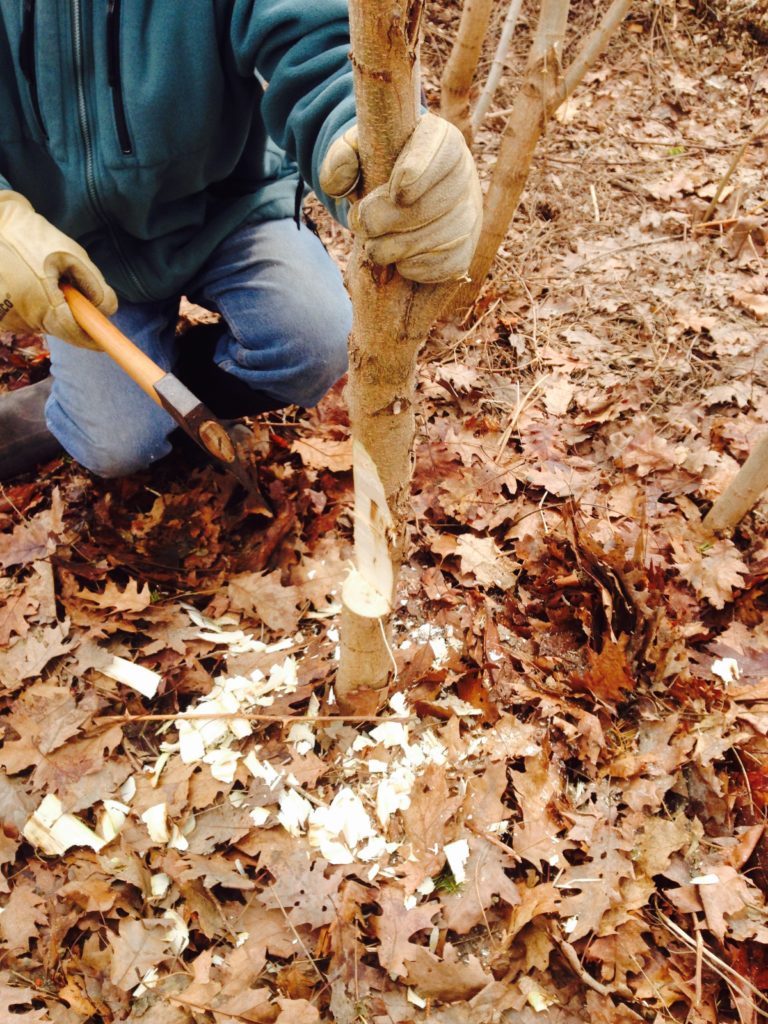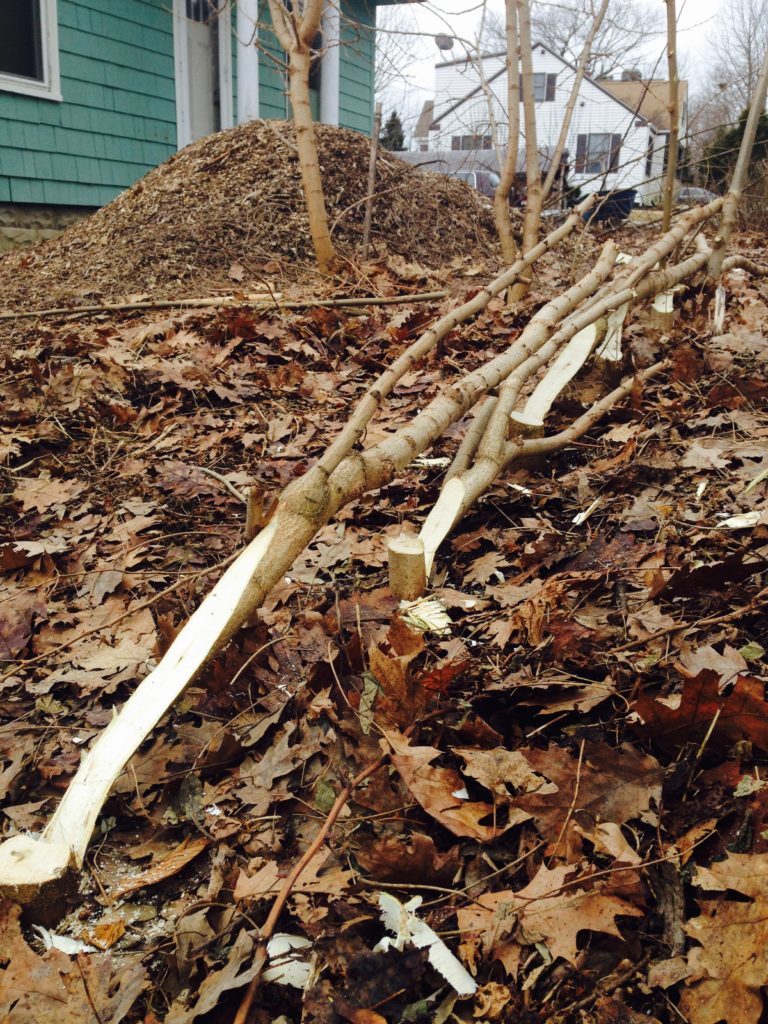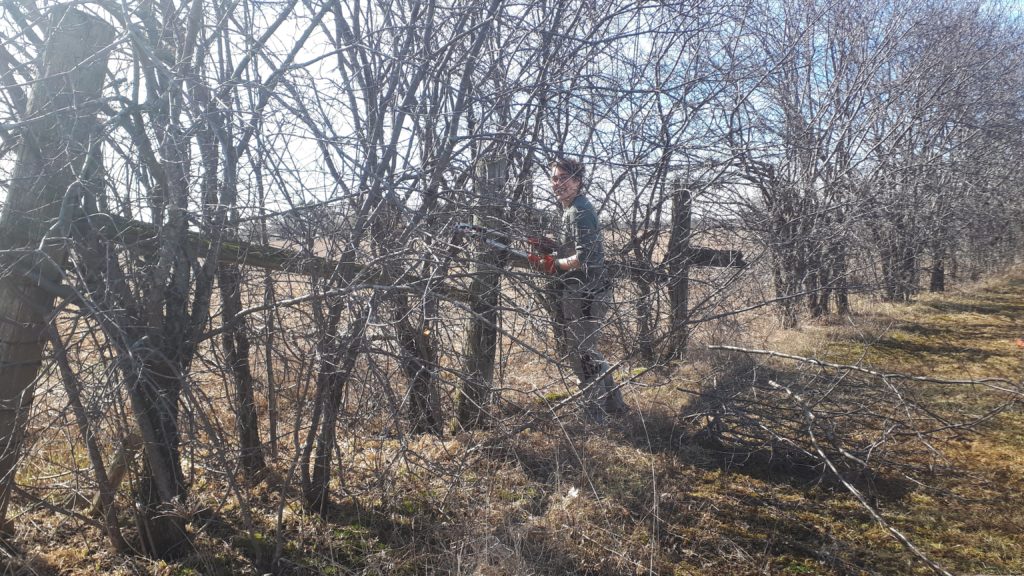Could hedgelaying catch on in the United States?
Forget the white picket fence. Hedgelaying may be the perfect fencing option for your homestead. Here’s what you need to know to try it.

Hedgelaying is the tradition of planting, cutting and shaping hedges to form a natural, makeshift fence on a property. The result, which are known as “hedgerows,” can stand in place of fences on farmland. Though they take longer to establish and require a certain level of skill and care, hedgerows are cheaper to set up than traditional fences and last for generations with proper maintenance.
Jim Jones, project manager at the Ontario Rural Skills Network, has been hedgelaying for about 10 years. An ecologist by training, he learned about the skill while studying the endangered dormouse, a woodland creature whose habitat is being fragmented in the United Kingdom.
“It’s an endangered species that thrives on woodlands which are getting scarcer and scarcer,” he said. “It needs to move between these woodlands.”
The secret, Jones found, might be in hedgerows, which provide connectivity between habitats that coexist with farmland in places where it is not feasible to, say, plant a whole new forest.
Jones visited Canada in 2016 when he was invited by fellow hedgelayer Nigel Adams to conduct hedgelaying workshops and demonstrations. Jones was eventually offered a temporary position at the University of Waterloo, and moved to Canada to continue his work laying inroads for hedgerows across the Atlantic.
For some United States homesteaders, hedgerows are already catching on. Lisa Fernandes, communication director for the Food Solutions New England Network, was drawn to the traditional, multipurpose land management skill and has experimented by growing hedgerows in her own yard about five miles outside of Portland, Maine.
“I consider our hedge a very successful experiment,” Fernandes said. “It’s excluding deer from our side yard [and] it’s creating a visual barrier. We trim it every two or three years, and that provides us a ton of kindling for our wood stove. It just fit perfectly with a permaculture mindset as a landscape feature that involves multiple elements at the same time.”
Growing in New England is a little different than growing in England. Fernandes said that not only are the species used slightly varied to adjust to native habitats, but the logistical matter of maintaining a hedgerow must adapt to the different climate.
“In the [United Kingdom], hedgelaying and maintenance is done over their winter, which is very mild,” Fernandes said. “Whereas for us, just like with our pruning season for fruit trees, we have to work around the weather. Sometimes we have so much snow on the ground we can’t get to the base of the trees to lay hedges. There’s just a little bit of different logistics.”
What species can be used for hedgelaying?
Aside from choosing a plant that will thrive in the area where the hedgerow is planted, the only requirement is that the species need to be able to regrow after coppicing, or being cut to the base.
“Almost any deciduous species will work because deciduous broadleaf species are the ones that will produce stump sprouts,” Fernandes said. “When you cut down the tree as long as the stump can be accessed by the sun there’s still a bit of photosynthesis happening and there’s enough of a root bank of energy that the stump will produce new life. That’s a feature of deciduous trees that you want to exploit.”
Fernandes said that traditionally hedgelayers would use trees like elm, birch and beech palm. In the United Kingdom, Jones said that hawthorne is a popular plant for hedgerows, though a variety of different plant species can be used to form hedgerows. Hedgerows can even be comprised of edible plants, like chokecherry.
“It’s possible to think that you can derive some kind of income from what you can grow in the hedgerow,” Jones said. “You can also plant trees, like plum or apple trees, every 15 or 20 meters along your hedge. It would be what we call a hedgerow trees.”
Hawthorne, blackthorne and mountain ash are among the plants that Fernandes said might work well in hedgerows in the United States, particularly in New England.
“There are a number of species that will work depending on your goal,” Fernandes said. “You just have to decide if you’re looking for something thorny to keep deer out, something that produces fruit, something that’s good for the bees, or something like birches and willows for basketry. The sky’s the limit, and people are really experimenting with different species.”
How does hedgelaying work?
If you are starting fresh with a new hedgerow, the first step is to plant the hedges in the spot.
“The initial thing is that it’s not quite ready to be a fence when it’s just a plant,” Jones said.
While the plant grows enough to lay, gather the necessary tools.
“I’ve used a really sharp hatchet [and] a billhook,” Fernandes said. “You don’t need much more than that — maybe a mallet for putting stakes in. Maybe pruners to trim out all the extra brush. You can start very basic, but like with any hobby or activity, you could, if you wanted to, spend a lot of money on specialty tools.”

Laying the hedgerow starts with cutting part-way through the stem, or “pleacher.”
“We don’t cut all the way through,” Jones said. “You cut two-thirds of the way through the plant. That pleacher is still living and will continue to grow from there. It’s a living fence.”
Then, you set the cut stem at an angle or laying on the ground, depending on the style of the hedgerow you are creating. Different parts of the United Kingdom have different styles of laying the cut hedges depending on the location. The type of farming you plan to use also influences the design of your hedge.

“Some of the pleachers are laid flat, some of them are laid horizontally,” Jones said. “There are different styles depending on the type of farming systems. If you have livestock on one side and a crop on the other side, the stems or pleachers laid towards the field, so all the knotty stuff is towards livestock and the freshly cut stems are towards the field. What you don’t want to happen is for livestock to come and nibble at places where new growth is happening.”
Then, you weave the hedges together and secure them with stakes and binders.
“To strengthen the hedge we use stakes, which mostly in my experience, hazel or ash, [which are] quite hard stakes, driven through the center of the hedge,” Jones said. “To make it really strong, use a binding, like hazel, around the tops of the stake. You can lay a bad hedge, and once you put the binding at the top, it looks like a million bucks.”
After they are laid, Jones hedgerows must be trimmed every two or three years to prevent overgrowth and re-lay them once every generation to keep them maintained.
“One of the things about hedgerows is that they need to be kept in good condition as a fence,” Jones said. “If you just let them to their own devices, or they’ll turn into trees. If the trees fall over, you lose the hedgerow.”
The benefits of hedgelaying
Hedgerows provide many ecosystem services that fences do not.
“They’re really good for pollinating insects in fields, and they’re really good in farm landscape good for lots of animals,” Jones said. “They stop the flow of water going over land, which has helped in flood management as well.”
Unlike manufactured fence posts, the plants in hedgerows are also useful for carbon sequestration, the plants’ natural process of capturing and strong carbon dioxide from the atmosphere.
“This is important, especially if you don’t have the space to plant a whole forest,” Jones said.

Logistically for farmers, hedgerows can be even more useful than a row of trees.
“They cause less shade, so if you’re looking at a crop in a field, [that is] really useful,” Jones explained. “Because because they have lots of stems per meter, they actually absorb more moisture into the field, [which is] good for crops as well. Managed hedgerows are really good shelter belts as well. They’ll cut out even more wind than trees”
The process of hedgelaying can also prolong the life of the plants.
“In doing so we prolong the life of trees,” Jones said. “Coppicing can prolong the life of a tree by a factor of ten times. There are hedgerows that are planted that are nearly 1,000 years old.”
Also, although hedgerows need regular maintenance, they won’t need to be replaced like fences, which can rot or otherwise fall into disrepair with age.
“Once the hedge is in, it’s in. you don’t have to keep replacing them,” Jones said. “You don’t have to worry about them breaking. They’re longer lasting.”
Fernandes said that frugal landowners may see hedgelaying as a sustainable, low-cost option for long-term benefit on their land.
“Because it relies and labor and skill more than many, it’s something that anyone can do,” she said. “If you don’t have the money to make a fence, you can make a fence with almost no money, [but] as long as we have relative wealth in landscaping, people will probably buy a fence.”
Aside from the logical advantages, Jones also enjoys the physical experience of laying a hedge.
“You’re outdoors, working with your hands,” Jones said. “It’s a bit of a mindfulness practice. You just have this puzzle that you have to find out and do.”
And, of course, there is the aesthetic aspect of hedgerows.
“A well-managed hedgerow is something beautiful to look at,” Jones said. “It creates a sense of place, a landscape that has been taken care of.”
Where can I learn hedgelaying?
The practice of hedgelaying is relatively new to the Western hemisphere. Workshops are sparingly offered through various institutions, like cooperative extensions permaculture centers. Fernandes said that she encouraged her students at permaculture classes at the Portland-based resilience hub to experiment with hedgelaying.
Jones said that there will be more opportunities to learn hedgelaying in the near future. He is working with other hedgelaying experts throughout the United States and Canada to establish the North American Hedgelaying Society, which he said was informally inaugurated at a New York state meeting in November 2019.
“Once the North American Hedgerow Society gets some money, we’ll be able to bring some professionals over from England and Europe and do some more workshops,” Jones said. ”At the moment people are going to have to hold tight a bit.”
In the meantime, he said, turn to YouTube.
“If people want to learn you can go online on YouTube and put ‘hedgelaying’ in,” Jones said. “There are lots of people who have done that online already.”
Jones hopes that one day, North America will develop its own take on this ancient skill.
“We really want something to develop in this part of the world that is of and speaks of the people,” Jones said.
Fernandes is not sure that hedgelaying will have the same mass appeal that it once had in the United Kingdom. Still, Fernandes has noticed interest in hedgelaying in certain groups.
“I feel like it’s one of a suite of practices that’s becoming more common in two areas,” she said. “One is natural and ecological landscaping and the other area is the people who are doing agroforestry work who are looking at how we manage trees differently for long term benefits other than timber.”
Still, she said, growing that interest — like growing a hedgerow — will take time.
“It took English people hundreds of years to develop their styles and pass on their skills,” Fernandes said. “It doesn’t happen overnight. This is a land management technique that evolved in a culture where people and families generally stayed in the same place for a long period of time or passed down skills for each other. Any hedgerow in America is going to be in its infancy.”
